- Home
- James A. Michener
Centennial Page 18
Centennial Read online
Page 18
He sat the boy on a rock and told him, “In the morning when you rise. At night before you go to sleep. And especially when you are the lookout on the hill. Always look to the four directions and ask yourself, ‘Where is my enemy hiding?’ ”
He said, “You must never be afraid of enemies ... or meeting them in battle. The noblest act for a warrior is to touch an enemy in battle ... to count coup. It would be shameful to die a coward ... without ever having counted coup.”
Lame Beaver listened. He knew as much about counting coup as did his father. Young boys talked about it all the time, of how they were prepared to rush up to any Ute and touch him with their hand or with a spear and thus count coup. They would even be prepared to face a Comanche on his horse, and brave his lance, in hopes of counting coup, for a man who failed to count coup could have no respected place among Our People. Lame Beaver had boasted to his playmates, “I would even run up to a Pawnee to gain coup,” but none of them believed this, for the Pawnee would probably have a horse and perhaps a black stick that spewed smoke and killed from a distance. “I would,” he repeated.
His father Gray Wolf grew silent, and after a long pause, said, “Only the rocks live forever. A warrior is born for his season and he fights as Man-Above allows. He respects Flat-Pipe and he gains what coups he can. And in the end, if he is lucky, he dies in battle, his hand against the enemy, gaining the greatest coup of all—death in victory.”
He spoke so gravely that Lame Beaver stopped thinking about counting coup in the battles that lay ahead and looked at him. Gray Wolf’s face was deeply lined and dust stood in the crevices. His eyes were sorrowful, and in that moment of silent communication Lame Beaver apprehended that his real father, Sun-at-Noon, had been killed. Averting his gaze, he asked, “Did he die in battle?” and Gray Wolf answered, “He was trying to count coup on a Pawnee.”
“Did he?” Lame Beaver asked.
“No,” Gray Wolf replied It would be futile to lie about such a thing, because that night when the warriors gathered at the campfire and reviewed the day’s battle, there would be harsh and honest decision as to who counted coup and who did not, and not even the death of a warrior known to be brave, like Sun-at-Noon, would warrant lying about whether he had made coup.
With Our People it was permitted that four warriors count coup on an enemy. The first to touch him shouted for all to hear “I first,” and the second, “I second,” and so on, but when the battle ended these warriors and their witnesses convened, and confirmation was sought, and a warrior might claim, “I gained first coup on the Pawnee chieftain,” but until someone confirmed this and said, “I saw him touch the Pawnee and he is first,” the award was not allowed.
Killing the enemy? That amounted to nothing. If it had to be done, it was done, but it did not count beyond whatever coup that might have been involved. Collecting a scalp? That also was nothing, an act some warriors performed when they wanted decorations for their tipi or their saddle. A warrior might kill an enemy and scalp him and still gain no credit if four other warriors had counted coup on him first.
“Sun-at-Noon failed?” the boy asked.
“He tried. The Pawnee had a horse and came too fast.”
“Did you bring his body home?”
“Only the rocks live forever,” Gray Wolf said. “The Pawnee took his body and scalped him and he is dead.” The boy sighed, for he knew that if his father had no scalp he could not enter the hunting grounds.
The following stories explain how Lame Beaver gained his own coups and became a great leader of Our People, but never chief.
1. Old Man Staked Out
In the spring of 1764, when Lame Beaver was seventeen years old, Our People met in conclave and decided it was humiliating to exist any longer without horses when the Comanche, the Pawnee and even the Ute had them. It was a situation requiring remedy, for it impeded the tribe in all ways. Not only was it a serious disadvantage in war; Our People also went hungry when the bison wandered too far to be located on foot. Even in moving from camp to camp the lack of horses distressed them, for they had to pack their goods on the backs of women or haul them on dog-travois—the A-shaped wooden frames whose rear legs dragged in dust—whereas the Pawnee, let alone the Ute, could haul theirs on horse-travois.
Therefore a thrill ran through the camp when Cold Ears, with coups to his credit, announced, “I am an old man. My teeth are breaking. My son is dead and I have no further desire to live. We must raid the Pawnee to capture horses, and when we do I shall stake myself out.”
Our People knew that it was the prerogative of a warrior to die in this manner, and all agreed that Cold Ears should be accorded the privilege. So when the war party was assembled, Cold Ears was awarded a prominent place and he took a public oath which resounded through the camp: “Three days from now Our People will have horses, for I shall stake myself out and not retreat until we get them.”
Lame Beaver was so inspired by this pledge that he begged for permission to go along, and it was granted, for he was known as a courageous youth. That night, as they set forth, stealthily lest the ever-watchful Pawnee detect them, he felt the excitement of his first expedition against a most devious foe. Stars shone, a good omen, and by their frail light he studied the route against the day when he might have to lead a war party eastward.
To his right ran the Platte, studded with islands, its course marked always by cottonwood trees. He marked each island in memory, and where the stream debouched, and where the beaver had their lodges. He listened to birds and studied how the river looked in that precious hour before dawn. It was his initiation into the precautions observed by Our People when approaching an enemy.
For three days the war party traveled eastward, covering large distances. During the heat of the day they slept in secluded areas, but as twilight approached, they started running at a brisk pace, which they maintained until dark. Then they moved stealthily through the night, after which they ran again, repeating the cycle till well after dawn. Cold Ears, who was past fifty, had no apparent difficulty keeping up and appeared stronger at the end of the third day than he had been at the beginning. He was ready for battle.
Shortly after sunset on the third day Lame Beaver and an older brave were sent forward to see if they could locate the Pawnee camp, which must be at hand, and they crept among the cottonwoods with such skill that they succeeded in evading Pawnee outlooks and approaching to within a quarter mile of the camp. It was located at the spot where the two Plattes began to move together and was in a sense disappointing, for it was not by any means a main camp.
Lame Beaver whispered, “It’s only a hunting party. Not a real camp.”
His companion replied, “They have horses. Look.”
There were horses, and Lame Beaver noticed with satisfaction that they were tethered at the west end of camp. That means, when they move out they’ll come this way.”
His friend said, “Cold Ears should stake himself out there,” and Lame Beaver saw that this would place the old man in direct line with the Pawnee march.
They crept back to camp, and the older man allowed Lame Beaver to speak first: “Not many Pawnee there.” Then he added, “But many horses. And they will come our way.”
With that reassuring news Our People did a reckless thing. They went to sleep. They posted a watch, of course, but they had been traveling for three days and were tired. Lame Beaver was much too excited to sleep, and he moved watchfully among the sleeping braves, listening to the night sounds with which he was so familiar: a coyote over there, a deer passing, a beaver slapping his tail, a night owl hooting in the far distance, a soft brush of wings closer at hand. He heard a rustle within the camp and moved to see what had caused it. Cold Ears could not sleep, either. He, too, was listening to the soft symphony of night, the last that he would probably ever hear.
“I’m afraid,” Cold Ears said. This seemed so unlikely that Lame Beaver gasped slightly, and Cold Ears laughed. Pulling the young warrior down beside him, he conf
ided, “I am always afraid when we fight the Pawnee, because they are so clever. They think up tricks we would never think of, and there is no way to counter them.”
In the darkness he recalled his many confrontations with this wily foe, and whatever he said testified to the superior brilliance of the Pawnee. “Why were they the first to catch horses?” he demanded, but before he could say more he saw in the faint light along the horizon what looked to be a large boulder. “Is that lookout asleep?” he asked in dismay. Together they studied the rock; then one shoulder moved and Cold Ears was satisfied that the lookout was alert.
“What happened was that the Pawnee realized they couldn’t go down and just steal horses from the Comanche. No better horsemen on the plains than Comanche, and they guard their horses. So what the Pawnee did is what we have to do ...” He rambled on, reconstructing the ruse by which the Pawnee deceived the Comanche and captured their first horses. They not only knew how to get them,” he said with grudging admiration. “When they got them home they knew how to breed them and make more. They’re clever people, but tomorrow we’ll take their horses from them.”
“Will they have some new way of defending themselves?” Lame Beaver asked.
The old man understood such apprehension and said reassuringly, “When I was young I wasn’t nervous before my first fight. I was terrified. It was against the Ute, and I shivered all night thinking they’d capture me and drag me back to their camp and make me marry one of their black daughters and raise dark children who would be Ute. But when the fight begins, the fear goes.”
Before dawn Cold Ears moved among the sleeping warriors and whispered to each, “This is the day we capture horses.” Our People prepared themselves, then crept close to the Pawnee camp, evading sentries with ancient skill, and when all was ready, Cold Ears bade his fellow braves farewell and moved silently forward, stopping behind a hillock on the fringe of the Pawnee camp.
“Man-Above,” Lame Beaver prayed, ‘make them come in his direction.”
For some reason the Pawnee were tardy in sending out that day’s scouting party, and a warrior standing close to Lame Beaver said with some concern, as if he were a Pawnee depending on bison for food, “If they do not leave soon, their hunting will not be good.”
With casual indifference, as if they had endless time, Pawnee scouts on the hill to the north started sending signals back to camp that bison were in sight, and activity began. Hunters began assembling at the western edge of camp and prepared to move out from between the low tipis. When they had moved clear of the camp, so that immediate retreat was impractical, Cold Ears disclosed himself and waved his arms to frighten the horses. They saw that he had tied himself to a stake and realized that he was the outpost of a major assault.
A Pawnee chief spurred his horse savagely, lowered his lance and drove directly at the self-tethered enemy, but with great dexterity Cold Ears evaded the lance, caught the shaft with his right hand and with a sudden twist tossed the Pawnee from his horse, slapping him with his left hand as he fell. It was a brilliant coup, one of the bravest in the annals of Our People.
“Get that horse!” Cold Ears shouted, but an alert group of Pawnee braves, aware that the riderless horse might be captured, surged after it, leaving Cold Ears tethered to the ground, and quickly surrounded the runaway, bringing it back safely to their side.
The battle was now engaged, and Cold Ears remained self-Pinioned, directing his companions how to proceed, and many coups were counted. But finally the superior speed and widsom of the Pawnee began to assert itself, and Our People had no choice but to retreat. With bitterness the signal was given.
At this point Cold Ears was required by his own pledge to stay where he was, held to the ground by bison thongs, and fight the enemy so long as his strength lasted. He could be released, but only if some head chief doubled back to untie the thongs with his own hands. When, as in this case, all were preoccupied elsewhere, he was forbidden to release himself.
None of these chiefs could come back to save him; they had enough to do to try to save Our People from a complete rout, so Cold Ears was left alone. Girding himself with the lance he had wrested in the first moments of battle, and with tears of failure in his old eyes, he watched Our People retreat—with no horses. Then he waited.
Three Pawnee urged on their horses and rode straight at him. By some miracle he avoided their lances and succeeded in laming one of the horses with his. The Pawnee stopped to attend their horse, much more important to them than any elderly staked-out brave, and when they turned to resume their attack against him, they saw a remarkable sight.
From the main body of the retreating enemy one young warrior had detached himself and now came running back to make a stand alongside the old man. It was Lame Beaver, and he reached Cold Ears before the Pawnee horsemen did. He ripped away the thongs and stood defiantly beside Cold Ears.
With courage and simple skill the two warriors held off the enemy, knocking aside their lances and fending off the blows with their warclubs. Step by step they retreated, and on the Pawnee’s fourth charge Lame Beaver reached up and actually touched one, counting a clear and unchallengeable coup.
This feat inspirited Our People, and they made a rush to surround Cold Ears and his savior, and when the Pawnee saw how determined these men on foot were, they withdrew their horses and terminated the action.
In this famous battle, which was cherished in the history of each tribe and told to white men a century later, eleven of Our People participated against nineteen Pawnee. Three of Our People were wounded and two Pawnee. No one was killed, of course, but if Cold Ears had not been set free by Lame Beaver, he would have been.
The battle was remembered by Our People not because of Cold Ears’ bravery, for old men had staked themselves out before, but because it marked the first public display of courage by Lame Beaver. The Pawnee never forgot it, because it was the opening blow of Lame Beaver’s forty-year war against them.
When the war party returned to Rattlesnake Buttes, there was lamenting. Once again Our People had failed to obtain horses. Nor did Lame Beaver garner any praise for having liberated Cold Ears, for that was a prerogative sacred to chieftains, and for him to have taken this upon himself was presumptuous.
He was rebuked in public, and it was this injustice which rankled and forever deterred him from seeking acclaim or office. The tribe did not declare him ineligible because of his youthful folly; his subsequent behavior more than erased this first error. It was rather that he discovered for himself the inherent undesirability of becoming a leader; it was an act of pomp engaged in by lesser men who enjoyed bedecking themselves in feathers. He would let others use office to proclaim their feats. He would concentrate on the feat itself, doing what had to be done ... in silence.
2. Three Against Three Hundred
In 1768, when Lame Beaver was twenty-one years old, he had one of those insights of extreme simplicity which mark superior men. He reasoned, “If we want horses, let’s go where the horses are.” And it was this that led him on his daring foray against the Comanche.
The vision came to him, as most good ones do, when he was preoccupied with hard work in a seemingly unrelated field. It was early autumn and Our People at Rattlesnake Buttes knew that for a safe winter they must lay away much more bison meat than they had so far been able to take. Here again it was that persistent matter of horses. The Pawnee and the Comanche could fan out, over vast distances and track down the bison where they were, and even the miserable Ute, when they came down out of their mountain strongholds, had horses for this purpose. But Our People had to track bison in the old way, the way Indians on the northern plains had been doing for a thousand years.
One morning a scout ran in with exciting news. A large herd had been sighted to the northwest and appeared to be moving in the right direction, although one could never tell for sure. Bison rarely moved in a discernible pattern; they milled about like a tornado which could set off on any heading. Still, one had to hope t
hat they would move into a position from which they could be maneuvered toward the chalk cliff. Our People had no alternative but to act upon the supposition that this might happen.
Accordingly, the whole tribe left Rattlesnake Buttes for the laborious trek westward to intercept bison; on the see, and day scouts brought exhilarating news that the bison were heading southeast. With luck they might be diverted toward the chalk cliff.
As they walked, Lame Beaver became increasingly aware of a tall and lovely girl fourteen years old called Blue Leaf, daughter of Cold Ears, whom he had saved at the stake-out. He had received no thanks for his heroic action, for the old warrior had wanted to die and now his life was needlessly prolonged; many held it against Lame Beaver that he had interfered, because Cold Ears now had to be looked after by his daughter. She, on the other hand, was grateful to Lame Beaver for extending her father’s life a few more years and did not complain about the extra work of providing food for him.

 Mexico
Mexico The World Is My Home: A Memoir
The World Is My Home: A Memoir Sayonara
Sayonara Chesapeake
Chesapeake The Novel
The Novel Rascals in Paradise
Rascals in Paradise Return to Paradise
Return to Paradise Presidential Lottery: The Reckless Gamble in Our Electoral System
Presidential Lottery: The Reckless Gamble in Our Electoral System The Source
The Source Poland
Poland Space
Space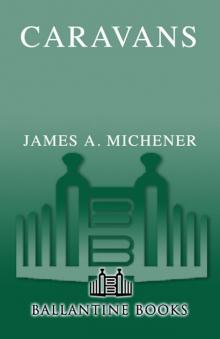 Caravans
Caravans Creatures of the Kingdom: Stories of Animals and Nature
Creatures of the Kingdom: Stories of Animals and Nature Iberia
Iberia Hawaii
Hawaii The Watermen: Selections From Chesapeake
The Watermen: Selections From Chesapeake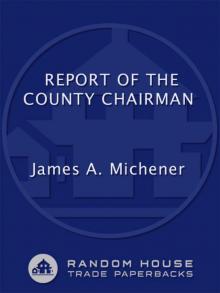 Report of the County Chairman
Report of the County Chairman The Covenant
The Covenant The Bridges at Toko-ri
The Bridges at Toko-ri Matecumbe
Matecumbe Journey: A Novel
Journey: A Novel Centennial
Centennial Sports in America
Sports in America Texas
Texas Miracle in Seville
Miracle in Seville This Noble Land: My Vision for America
This Noble Land: My Vision for America Tales of the South Pacific
Tales of the South Pacific Bridges at Toko-Ri
Bridges at Toko-Ri Space: A Novel
Space: A Novel Presidential Lottery
Presidential Lottery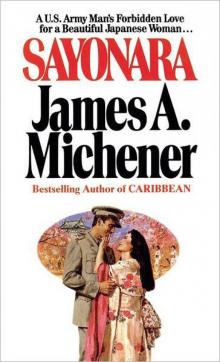 Sayonara: A Novel
Sayonara: A Novel This Noble Land
This Noble Land The Covenant: A Novel
The Covenant: A Novel Miracle in Seville: A Novel
Miracle in Seville: A Novel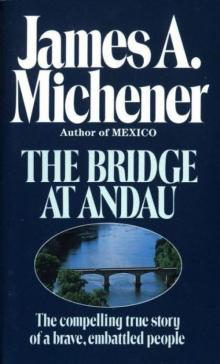 The Bridge at Andau
The Bridge at Andau Source
Source The Source: A Novel
The Source: A Novel Journey
Journey Recessional: A Novel
Recessional: A Novel Legacy: A Novel
Legacy: A Novel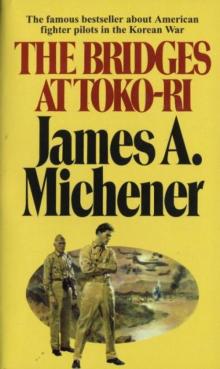 The Bridges at Toko-Ri: A Novel
The Bridges at Toko-Ri: A Novel Poland: A Novel
Poland: A Novel